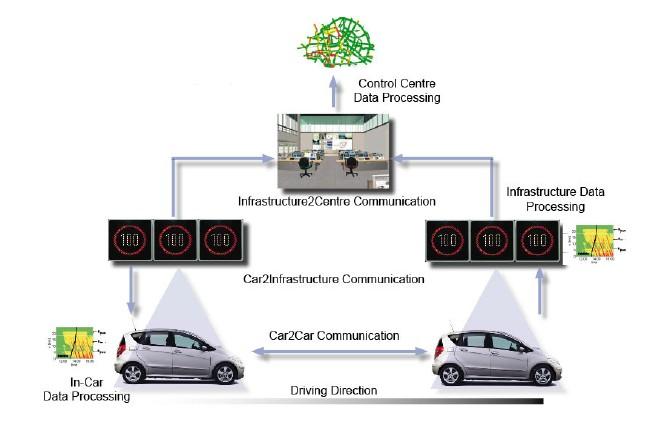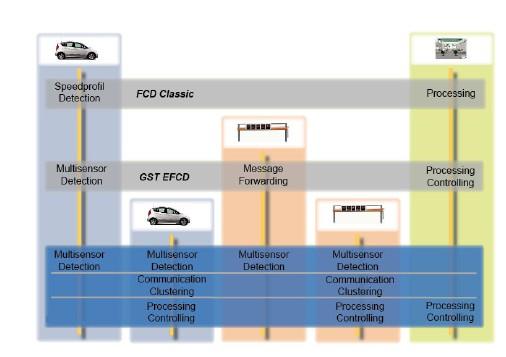COOPERATIVE MONITORING
Traffic and environmental monitoring is today one essential backbone of enhanced traffic and incident management applications as well as for traffic related information services. The COMO Sub-project approaches this topic by bringing the world of fixed roadside sensors together with mobile sensors and providing distributed applications for data provision and data fusion for enhanced service speed.
The high data volume generated by fixed and mobile sensors requires new, innovative approaches to achieve fast response times and a reasonably (in-)expensive data communication between the vehicles, the roadside units and the centres. Since fully centralised systems might not be able to serve all of these goals, CVIS aims on a cooperative system environment in which COMO is implementing applications for data collection, data fusion and (potentially) other related CVIS applications. The interaction concept of COMO is shown below.

(click on picture to enlarge)
Objectives
As mentioned above, COMO aims to develop specifications and prototypes for the collection, integration and delivery of extended real-time information on individual and collective vehicle movements and on the state of the road network.
Thus the sub-project has three major objectives, namely to:
- provide cooperative applications with a communication interface that enables them to access monitoring data anywhere and at any time, thus capturing the details of the underlying monitoring infrastructure of probe vehicles and infrastructure sensors. Inside CVIS the application interface will be used by the application oriented subprojects urban (CURB), inter-urban (CINT) and fleet & freight (CF&F).
- develop and provide a standardised interface providing data gathered by the vehicle as well as by the local sensor infrastructure, that can be used by a qualified service provider for various purposes.
- develop the distributed algorithms for data fusion that are required to provide the COMO service to the applications, based on the data delivered by the standardised interface. The data fusion methods will be developed in strong cooperation with the application oriented sub-projects in order to meet their requirements.
COMO will also closely cooperate with the Deployment Enablers Sub-project (DEPN) to establish a business case for the operation of COMO that addresses all non-technical issues.
Innovation
Based on the interaction between the three involved entities cars, infrastructure and operation centre the figure below is showing the space for innovation within COMO. In a first development stage FCD approaches used the speed-profile for data gathering as well as for the event detection. The communication was limited to transmission of data from the car to the centre. In order to improve the information quality GST/EFCD is connecting the vehicle-bus for a multi-sensor data processing and detection inside the car. Furthermore the communication between the car and Centre is bidirectional to enable a detection control inside the car. The EFCD approach is supporting the communication with the infrastructure to forward messages to the service centre. But the infrastructure is only a communication hop without any intelligence for data processing methods.

(click on picture to enlarge)
Now COMO introduces a decentralised system approach to monitoring, supporting the direct communication between cars and infrastructure.
COMO in CVIS
The COMO Sub-project is placed as a central basic service inside the CVIS framework. COMO will cooperate closely with the application oriented activity blocks for urban (CURB), inter-urban (CINT) and fleet & freight (CF&F) applications to capture their particular requirements about monitoring of traffic and environmental information.
The services are based on a consistent set of interfaces, which is applicable throughout the entire CVIS platform to control and manage the required transactions and data flows between vehicles, roadside infrastructure and back office systems like service or traffic management centres. In order to ensure the cooperation between these three entities COMO will provide distributed and decentralised data processing components.
In comparison with conventional FCD schemes, CVIS will potentially capture far more data, and from more vehicles (since all vehicles will be able – through use of standard-based onboard units – to contribute data, not just those subscribing to a specific service). While this will provide the highest quality information on the real-time status over the entire road network, it will also lead to an enormous growth in data communications volume. A major challenge therefore for COMO is to create a distributed architecture where a maximum of processing can be done locally, in individual or amongst groups of vehicles, and where the volume of data transmissions can be moderated according to the context and content of the data (so that more data are transmitted that refer to an important exception – e.g. traffic incident – than for non-changing or slowly changing traffic status).
COMO will provide the tested reference design as an open source implementation to the field trials in the Test Sites. The services will be implemented on the FOAM platform and integrated in the local target environment.
Contact
Axel Burkert
COMO Sub-project Leader
Planung Transport Verkehr AG
E-mail: axel.burkert@ptv.de
Sub-Project Partners
|